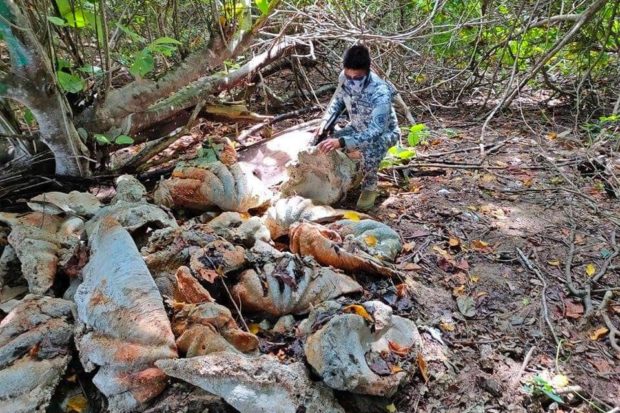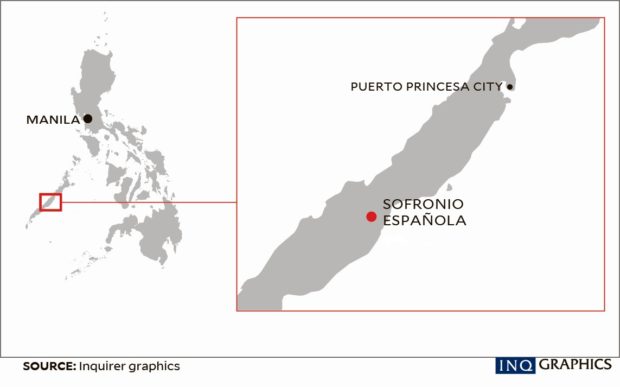P250-M giant clam shells seized in Palawan

ISLAND HOARD The discovery of at least 150 tons of giant clam shells, locally known as “taklobo,” on a private island in the village of Panitian in Sofronio Española, Palawan, comes after similar seizures in the province in April and February. —PHOTO COURTESY OF PHILIPPINE COAST GUARD PALAWAN
PUERTO PRINCESA CITY—Around 150 tons of fossilized giant clam shells coveted for their ivory-like quality were recovered by the police and the Philippine Coast Guard (PCG) on a private island in the village of Panitian in the southern Palawan town of Sofronio Española.
The giant clams, locally known as “taklobo,” were found in the undeveloped section of the 26-hectare King’s Paradise Island, where a resort had operated until it shut down in June last year at the onset of the coronavirus pandemic. Authorities estimated the haul to be worth P250 million.
The PCG identified four residents from the mainland village of Iraray as suspects behind the illegal trade of taklobo but only Eulogio Josos Togonon was arrested when authorities swooped down on the island on June 28. The other suspects who eluded arrest were identified only as Totong Josos, Nonoy Guliman and Vilmor Pajardo.
The four will face charges for violation of Republic Act No. 9147, or the Wildlife Resources Conservation and Protection Act, said Cmdr. Severino Destura, deputy chief of the PCG Palawan, in an interview on Thursday.
The giant clam shells were turned over to village officials of Panitian after a joint inventory by representatives from the PCG, the Philippine National Police Maritime Group and the Palawan Council for Sustainable Development (PCSD).
Article continues after this advertisementTricked
Jovic Fabello, spokesperson for the PCSD, a government environmental agency mandated to protect the natural resources of Palawan, said locals were tricked into engaging in the illegal activities by people who offered them money and who claimed they had government permits to engage in the trade of taklobo shells.
Article continues after this advertisement“The prevalent market value is around P2,000 per kilo. Usually, there are larger organized groups behind this who tell the residents that it is allowed to harvest or collect these giant clam shells,” Fabello said in a telephone interview.
The giant clams came close to extinction in the 1980s due to indiscriminate harvesting by locals for food and shellcraft until strict laws were enforced, such as RA 9147, which was enacted in March 2001, to protect the species.
While the clams are sought after for their meat, their shells have been prized as alternative material for jewelry, chandeliers, religious icons and other products, attracting smugglers who have turned to this endangered species as a substitute to the illicit ivory trade.
They’re everywhere
Fabello said it was a challenge for environmental agencies to identify where giant clam shells were being harvested since the waters of Palawan have a natural population of giant clams.
“To help mitigate the problem, we are doing information education campaign in each barangay [and] installing tarpaulins [that] inform residents that it is prohibited under the law [to collect giant clams],” Fabello added.
Just this year, several tons of fossilized giant clam shells had been seized by law enforcement officers.
On April 16, two fishers were arrested at Sitio Green Island in the coastal village of Tumarbong in Roxas town in what authorities described as their “largest haul” of about 200 tons of giant clam shells, with an estimated market value of P1.2 billion.
Just days earlier, on April 13, at least 26 tons of abandoned giant clam shells, worth P57 million, were also found in a coastal community in Narra town.
On Feb. 6, 90 pieces of abandoned giant clam shells were also found at Barangay Sibaltan in El Nido town. INQ
